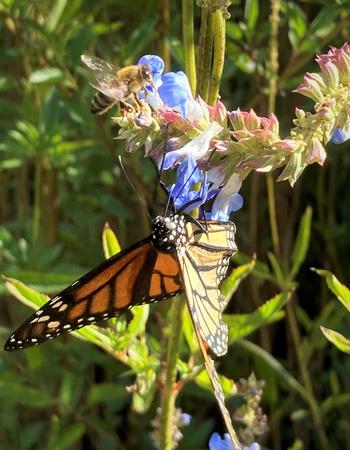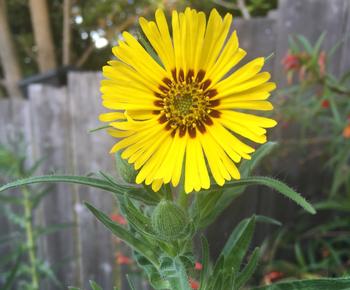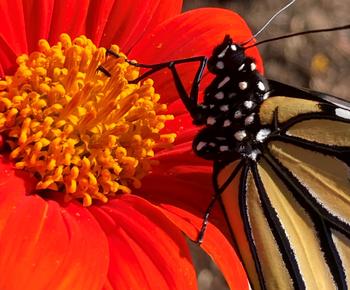A wish list for pollinators – host and nectar
-
Alice Cason
-
To create a thriving habitat that will sustain the complete life cycle of butterflies and moths, you will need plants that act as host plants and plants with nectar or a food source. The Greek gods supposedly ate ambrosia and drank nectar. So what is it that attracts hummingbirds and butterflies to your garden? It is a sweet liquid produced by flowers and flowering plants. It is a source of energy and calories. Nectar is rich in vitamins, salts, oils, and other nutrients. It is produced in the glands of the plant called nectaries. The nectar attracts a pollinator, like a bee. When foraging, pollen sticks to a bee. When it moves to the next flower, some pollen is transferred, and fertilization occurs. The pollinator is out for a meal but unwittingly helps the plant to reproduce.
 A honey bee and a monarch butterfly share the nectar on Salvia ulignosa, Blue spike sage. Photo: Alice Cason
A honey bee and a monarch butterfly share the nectar on Salvia ulignosa, Blue spike sage. Photo: Alice CasonSome species need their own type of host plant. For example, a monarch butterfly‘s life begins with a milkweed plant. It is the sole source of food for the caterpillars or larva. After eating the plant, they gain poisonous cardenolides, protecting them from predators. Milkweeds plants are the only place where the Monarchs will lay eggs and a support system for their complete metamorphosis. Remember to plant milkweeds native to Marin (Asclepias fascicularis and Asclepias speciosa) and not tropical milkweed (Asclepias curassavica), which disrupts the monarch migration can have a high infestation of the OE parasite whose spores accumulate in the leaves. I found a great list of California host plants for butterflies at: https://sonomamg.ucanr.edu/files/29782.pdf.
Some plants are better than others for nectar production. Some double bloom varieties with ruffled petals will be hard to navigate and inaccessible. There are also hybrid plants that do not provide pollen, nectar, or fragrance. Look for single bloom varieties of zinnias, for example. Nectar plants can be native wildflowers. They can also be trees, shrubs, and vines. Nectar plants can be host plants, too, like the passion vine (Passiflora), which is the host to the Gulf Fritillary butterfly.
Bees are the world’s most prolific pollinators looking for nectar plants. In California, we have over 1600 types of native bees and the European honey bee that turns nectar into honey. Watch for long-horned bees, Melissodes sp, who nest in the ground, Sweat Bees (Halictus ssp> Bumble Bees, Carpenter bees (Xylocopa sp.) For suggestions on planting for bees, see Best Bee Plants for California - UC Berkeley Urban Bee Lab (helpabee.org). The bright yellow blossom on the Madea elegans, or tarweed, attracts bees, butterflies, and moths. Photo: Alice Cason
The bright yellow blossom on the Madea elegans, or tarweed, attracts bees, butterflies, and moths. Photo: Alice CasonMarin Master Gardeners have assembled a list of over 40 Pollinator plants for bees and butterflies for a special sale held at the Falkirk Greenhouse in San Rafael. Watch for California natives like Achillea Millefolium (Yarrow) and Eschscholzia californica (Orange California Poppy). In addition, there are several varieties of Nepeta (Catmint). Salvias, Scabiosa and Verbena. Tithonia, or Mexican Sunflower, is a favorite for butterflies because of its bright red color, open structure, and single petals. Also in the sale is Madia Elegans or Elegant Tarweed, a California native annual drought tolerant and deer resistant. Bees and Syrphid flies pollinate it. The flower heads are like bright yellow sunflowers and close on hot days as an efficient way to avoid wilting.
After overwintering in small forested areas along the Pacific Coast, the Western Monarchs migrate inland to breed starting in February. They arrive in Marin County hungry for nectar plants and looking for their larval host plants, milkweeds, where they will lay eggs. Native Milkweeds and much more will be on sale at The UC Marin Master Gardener Pollinator Plant Sale Saturday, March 12, from 9 – 12:00 at the Falkirk Greenhouse, 1408 Mission Ave., San Rafael. Master Gardeners will be on hand to advise on which plants go together to provide a constant food source throughout the year. Monarchs like the open shape and bright red color of the Tithonia flower ( Mexican Sunflower). Photo: Alice Cason
Monarchs like the open shape and bright red color of the Tithonia flower ( Mexican Sunflower). Photo: Alice Cason



